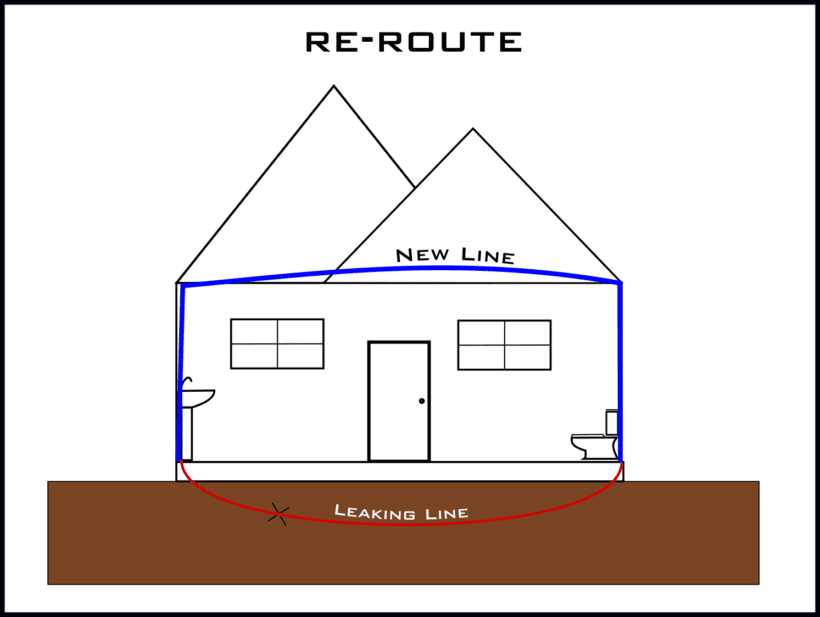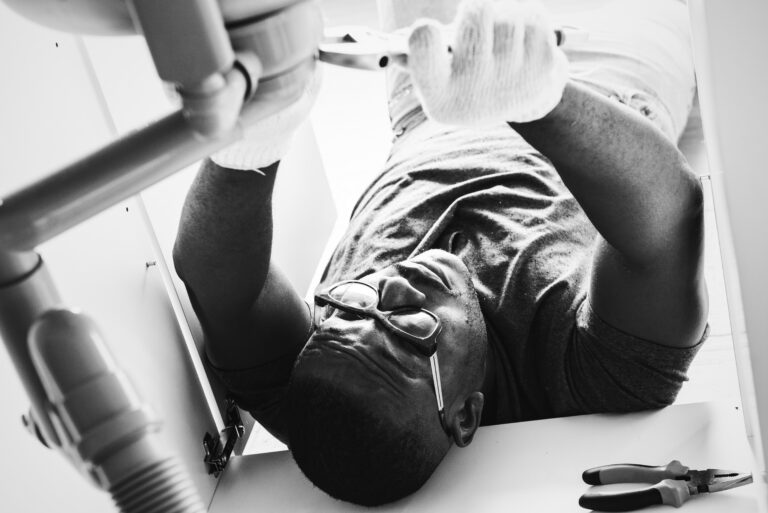Rerouting Plumbing Lines In Slab Foundation
Rerouting plumbing lines in a slab foundation is a process that involves moving existing plumbing lines in a slab foundation. This process can be required to expand a bathroom or kitchen, add an extra bathroom, or replace a damaged or corroded pipe. It involves cutting and removing sections of the concrete slab, digging out the existing pipes, and replacing them with new pipes. This process can be complicated and time-consuming, and should only be performed by an experienced professional plumber.
Preparing for the Job
Preparing for a job that involves rerouting plumbing lines in a slab foundation can be a daunting task. Knowing the right steps to take and having the necessary tools and materials to complete the job are essential for success. In this blog post, we’ll look at the key considerations for rerouting plumbing lines in a slab foundation, such as assessing the current plumbing layout, making sure to have the right tools and materials, and understanding the steps involved in the process. We’ll also look at common mistakes to avoid and tips for ensuring a successful rerouting. With this information, you’ll be ready to tackle any plumbing rerouting project with confidence.
Understanding the Slab Foundation
When it comes to plumbing work, a slab foundation can be a tricky surface to deal with. When plumbing lines need to be rerouted, extra care has to be taken to ensure that the project is done correctly and that the structure of the home is not compromised. To understand the work involved in rerouting plumbing lines in a slab foundation, it is important to first understand the basics of slab foundations.
A slab foundation is a flat surface of concrete, which serves as the base of a building. This foundation is usually poured directly onto the ground and is reinforced with steel rebar to make it more stable. Slab foundations are most commonly used in homes with a single story and are used to support the weight of the structure. They are also a popular choice for homes in warm climates because they are not as susceptible to ground freezing and thawing.
When plumbing lines have to be rerouted in a slab foundation, extra caution must be taken to ensure that the foundation remains intact and that the integrity of the structure is not compromised. This may involve core drilling into the slab or using a jackhammer to break through the concrete. An experienced plumber will be able to assess the situation and determine the best course of action for the project.
Overall, rerouting plumbing lines in a slab foundation may require extra caution and care, but with the right professional, it can be done efficiently and effectively.
Accessing the Plumbing Lines
Rerouting plumbing lines in a slab foundation can be a daunting task. Accessing the lines is the first challenge, and it needs to be done with precision. The slab foundation is a monolithic structure and requires careful excavation to access the plumbing lines. The first step is to determine the location of the lines and mark the area for excavation. A jackhammer might be used to break through the slab to access the lines. Once the lines are exposed, they can be disconnected and rerouted. It is important to use an experienced professional when rerouting plumbing lines in a slab foundation, as the job requires specialized knowledge and skill. Plumbers need to be aware of the risk of damaging the foundation when they are rerouting the lines. Proper safety measures must be taken to ensure that the task is done safely and that the foundation is not damaged in the process. Accessing the plumbing lines in a slab foundation is a difficult job, but with the right professional, it can be done quickly and efficiently.

Rerouting the Plumbing Lines in a Slab Foundation
Rerouting the Plumbing Lines in a Slab Foundation can be a daunting task for many homeowners. It is a complex process that requires the expertise of a professional plumber. Fortunately, with the right planning and preparation, the job can be done correctly and efficiently.
When rerouting plumbing lines in a slab foundation, the first step is to determine the best path for the new plumbing lines. This requires an assessment of the existing slab to identify the most suitable route for the pipes. The plumber must also consider the necessary clearance to ensure that the pipes are not too close to electrical wiring or other structures that could be damaged by the plumbing work. Additionally, the plumber must take into account the slope of the foundation, the type of piping being used, and the location of the plumbing fixtures.
Once a plan has been devised, the plumber can begin the rerouting process. This involves cutting and removing the existing slab, installing the new plumbing lines, and then sealing the slab back into place. The plumber should also ensure that the new plumbing lines are correctly connected and tested for leaks.
Rerouting the Plumbing Lines in a Slab Foundation can be a complicated and time-consuming job, but with the right planning and preparation, the job can be done correctly and efficiently. By enlisting the services of a qualified and experienced plumber, homeowners can ensure that their plumbing lines are rerouted correctly, securely, and without any damage to their property.
Testing the New Plumbing Lines
Rerouting plumbing lines in a slab foundation requires a meticulous approach to ensure the new plumbing lines are properly tested before use. To guarantee the lines are operating correctly, it is essential to inspect the lines for any blockages or leaking joints. The best way to test the new plumbing lines is to apply water pressure to the system and observe the pressure gauge to ensure the lines are capable of sustaining consistent pressure. Additionally, it is important to inspect the lines for any signs of corrosion or damage. If any of these issues are present, the lines should be replaced or repaired before use. Finally, to ensure the lines are in proper working order, they should be tested for any backflow issues or cross-connections.
Testing the new plumbing lines is a critical step in the process of rerouting them in a slab foundation. By properly testing the lines, homeowners can ensure their plumbing system is operating effectively and efficiently. Additionally, this step helps to prevent any potential issues that could arise from faulty plumbing lines.
Finishing the Job
When it comes to rerouting plumbing lines in a slab foundation, it’s important to make sure the job is finished properly. After all, any flaws or mistakes could lead to expensive repairs down the line. So, how can you ensure your plumbing job is done right?
First of all, you’ll need to make sure that all the plumbing lines are routed properly. This means ensuring that the pipes are securely fastened to the walls and flooring and that all the connections are airtight. You’ll also need to make sure the pipes are properly insulated to prevent any water loss.
Next, you’ll need to test the system. This is to make sure that all the pipes are functioning properly and that there are no leaks. If there are any irregularities, you’ll need to go back and double-check the plumbing lines and connections.
Finally, you’ll need to seal the pipes and connections. This will ensure that no water can escape and that all the plumbing lines are securely fastened. You’ll also need to seal the walls and flooring around the plumbing lines to prevent any water from seeping into the foundation.
Rerouting plumbing lines in slab foundation isn’t always an easy job. However, if the job is done correctly, it can provide you with a reliable plumbing system for years to come. By following the tips above, you can make sure that your plumbing job is done right.
FAQs About the Rerouting Plumbing Lines In Slab Foundation
1. What type of construction is required when rerouting plumbing lines in a slab foundation?
Answer: When rerouting plumbing lines in a slab foundation, a professional plumber will typically need to cut into the slab and add a new PVC drain line or copper piping. The plumbing lines will then need to be reconnected with new fixtures and fittings.
2. How long does it take to reroute plumbing lines in a slab foundation?
Answer: The duration to reroute plumbing lines in a slab foundation will depend on the complexity of the job, but typically it will take a few days to complete.
3. Is it necessary to replace the slab when rerouting plumbing lines?
Answer: No, it is not necessary to replace the slab when rerouting plumbing lines. The plumber will simply need to cut into the slab to access and reroute the plumbing lines.
Conclusion
In conclusion, rerouting plumbing lines in slab foundation can be a difficult task, but with the right tools and materials, it can be done successfully. It is essential to hire a professional plumber to ensure that the job is done most safely and efficiently. Proper preparation and careful planning are essential to ensure that the plumbing lines are properly rerouted in the slab foundation. Ultimately, the success of the rerouting project depends on the skill and knowledge of the plumber.







